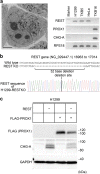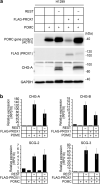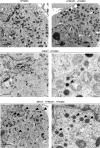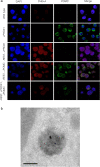Endocrine secretory granule production is caused by a lack of REST and intragranular secretory content and accelerated by PROX1
- PMID: 35094211
- PMCID: PMC9117388
- DOI: 10.1007/s10735-021-10055-5
Endocrine secretory granule production is caused by a lack of REST and intragranular secretory content and accelerated by PROX1
Abstract
Endocrine secretory granules (ESGs) are morphological characteristics of endocrine/neuroendocrine cells and store peptide hormones/neurotransmitters. ESGs contain prohormones and ESG-related molecules, mainly chromogranin/secretogranin family proteins. However, the precise mechanism of ESG formation has not been elucidated. In this study, we experimentally induced ESGs in the non-neuroendocrine lung cancer cell line H1299. Since repressive element 1 silencing transcription factor (REST) and prospero homeobox 1 (PROX1) are closely associated with the expression of ESG-related molecules, we edited the REST gene and/or transfected PROX1 and then performed molecular biology, immunocytochemistry, and electron and immunoelectron microscopy assays to determine whether ESG-related molecules and ESGs were induced in H1299 cells. Although chromogranin/secretogranin family proteins were induced in H1299 cells by knockout of REST and the induction was accelerated by the PROX1 transgene, the ESGs could not be defined by electron microscopy. However, a small number of ESGs were detected in the H1299 cells lacking REST and expressing pro-opiomelanocortin (POMC) by electron microscopy. Furthermore, many ESGs were produced in the REST-lacking and PROX1- and POMC-expressing H1299 cells. These findings suggest that a lack of REST and the expression of genes related to ESG content are indispensable for ESG production and that PROX1 accelerates ESG production.Trial registration: Not applicable.
Keywords: Endocrine secretory granule; Non-neuroendocrine lung cancer; POMC; PROX1; REST.
© 2021. The Author(s).
Conflict of interest statement
The authors have no conflicts of interest to declare that are relevant to the content of this article.
Figures





Similar articles
-
PROX1 Promotes Secretory Granule Formation in Medullary Thyroid Cancer Cells.Endocrinology. 2016 Mar;157(3):1289-98. doi: 10.1210/en.2015-1973. Epub 2016 Jan 13. Endocrinology. 2016. PMID: 26760117
-
Secretory granule biogenesis and neuropeptide sorting to the regulated secretory pathway in neuroendocrine cells.J Mol Neurosci. 2004;22(1-2):63-71. doi: 10.1385/JMN:22:1-2:63. J Mol Neurosci. 2004. PMID: 14742911
-
Carboxypeptidase E and Secretogranin III Coordinately Facilitate Efficient Sorting of Proopiomelanocortin to the Regulated Secretory Pathway in AtT20 Cells.Mol Endocrinol. 2016 Jan;30(1):37-47. doi: 10.1210/me.2015-1166. Epub 2015 Dec 8. Mol Endocrinol. 2016. PMID: 26646096 Free PMC article.
-
The chromogranins: their roles in secretion from neuroendocrine cells and as markers for neuroendocrine neoplasia.Endocr Pathol. 2003 Spring;14(1):3-23. doi: 10.1385/ep:14:1:3. Endocr Pathol. 2003. PMID: 12746559 Review.
-
Secretory granule biogenesis and chromogranin A: master gene, on/off switch or assembly factor?Trends Endocrinol Metab. 2003 Jan;14(1):10-3. doi: 10.1016/s1043-2760(02)00011-5. Trends Endocrinol Metab. 2003. PMID: 12475606 Review.
Cited by
-
Effects of Smart Drugs on Cholinergic System and Non-Neuronal Acetylcholine in the Mouse Hippocampus: Histopathological Approach.J Clin Med. 2022 Jun 9;11(12):3310. doi: 10.3390/jcm11123310. J Clin Med. 2022. PMID: 35743382 Free PMC article.
References
MeSH terms
Substances
Grants and funding
LinkOut - more resources
Full Text Sources
Research Materials
Miscellaneous

